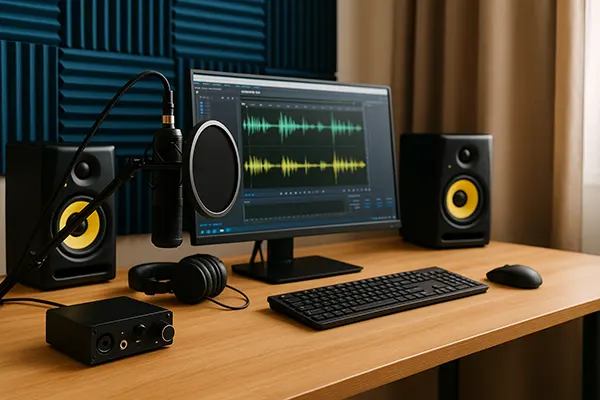
Home Audio Studio: How to Turn Your Voice into Income
Creating a home audio studio has become one of the most accessible ways to build a sustainable income stream in 2025. With the rise of audiobooks, podcasts, online courses and commercial narration, skilled voice talent is increasingly in demand. Building a studio at home allows you to work with flexibility, reduce production costs and develop your own professional workflow without investing in rented facilities or external services.
Essential Equipment for a Professional Home Audio Setup
A reliable home audio studio begins with the right technical foundation. The most critical element is the microphone, as its quality directly shapes the clarity and texture of your recordings. Many voice professionals prefer large-diaphragm condenser models, which provide a natural sound and reliable sensitivity. Equally important is pairing the microphone with a dependable audio interface to capture vocals accurately while avoiding distortion.
Acoustic treatment also plays a crucial role in maintaining recording quality. Simple solutions, such as acoustic foam, bass traps or isolation shields, help reduce unwanted reflections and create a controlled environment. Even a small room can deliver impressive results when treated properly, particularly when combined with absorbent surfaces and thoughtful placement of equipment.
Your computer and software form the core of the production chain. A modern laptop or desktop with sufficient RAM and processing power ensures smooth operation when recording and editing. Popular software such as Audacity, Adobe Audition or Reaper provides tools for editing, noise management and mastering. Selecting a program you feel comfortable with contributes to a more productive workflow.
How to Build a Comfortable Workspace
A well organised workspace helps you maintain focus and deliver consistent performance. Choosing a quiet room away from household noise reduces the time spent editing and cleaning audio tracks. Invest in a stable desk, an ergonomic chair and proper lighting to support longer recording sessions without fatigue.
Ventilation and room temperature influence the health of your voice. Dry air can strain vocal cords, so many voice professionals use humidifiers to maintain comfort. Keeping water at hand during sessions ensures you can maintain clear vocal performance without interruptions.
Finally, consider separating your recording zone from your editing area. While this is not always possible in smaller rooms, even minor changes such as a repositioned desk or mobile acoustic panels can help create a more functional environment. The goal is to establish a consistent routine that supports creativity and efficiency every day.
Developing Voice Skills for Paid Work
To turn your voice into a dependable income source, it is essential to train and strengthen your vocal abilities. Regular warm-up exercises improve breath control, articulation and endurance, helping you maintain quality throughout multiple sessions. Many voice artists also study acting techniques to refine expression and emotional range.
Understanding microphone technique is another key skill. Adjusting distance, speaking angles and volume allows you to manage plosive sounds, sibilance and tonal balance. A refined technique reduces the need for heavy editing and results in more natural-sounding recordings.
Keeping your voice healthy is equally important. Adequate hydration, avoiding strain and maintaining a balanced lifestyle directly affect vocal performance. Consistency is essential, as clients expect the same tone and quality across ongoing projects such as audiobook series or long-term commercial work.
Building a Portfolio That Attracts Clients
A strong portfolio helps potential clients evaluate your range and suitability for different types of projects. Create several samples that showcase your versatility: narration, conversational tone, character voices or educational delivery. Re-recording these samples as your skills and equipment improve ensures your portfolio remains current.
Publishing your samples on well-known marketplaces helps increase exposure. Many professionals rely on platforms that specialise in voice work to reach clients in advertising, entertainment and education. Presenting your samples with clear descriptions and consistent audio quality increases the likelihood of receiving inquiries.
Gathering testimonials and reviews from initial clients also strengthens your reputation. Positive feedback signals reliability and professionalism, which is particularly valuable for long-term collaborations. Keeping your contact information visible and responding promptly to messages also helps build trust.

Ways to Monetise Your Home Audio Studio
There are multiple revenue streams available to voice professionals in 2025. Audiobook narration remains one of the most popular options, as publishers frequently contract independent narrators for fiction and non-fiction titles. Rates typically depend on experience, length of the project and the overall scope of the work.
Commercial work offers another promising opportunity. Brands often require authentic voice recordings for promotional materials, explainers or product videos. Many freelancers also record IVR systems, e-learning lessons and advertising content for small businesses, which provides a broad range of ongoing jobs.
Content creation has also become a profitable avenue. Launching your own podcast, creating voice-based tutorials or producing sound libraries may generate long-term income. These projects allow you to build a personal brand while diversifying the range of your professional activities.
How to Find Clients and Grow Your Career
Client acquisition begins with active participation in professional communities. Many voice artists join dedicated online groups or forums to share experiences, receive recommendations and discuss technical matters. These communities also help you stay informed about industry developments and available opportunities.
Cold outreach remains an effective method for connecting with potential clients. Sending personalised messages to production companies, marketing agencies and publishers introduces your services directly to those who often require reliable voice talent. Including short samples or links to your portfolio helps recipients assess your suitability.
Maintaining long-term relationships is essential for career growth. Delivering work on schedule, offering revisions when needed and communicating clearly establishes your reputation as a dependable professional. Returning clients often bring stable income, while their recommendations open doors to new collaborations.
